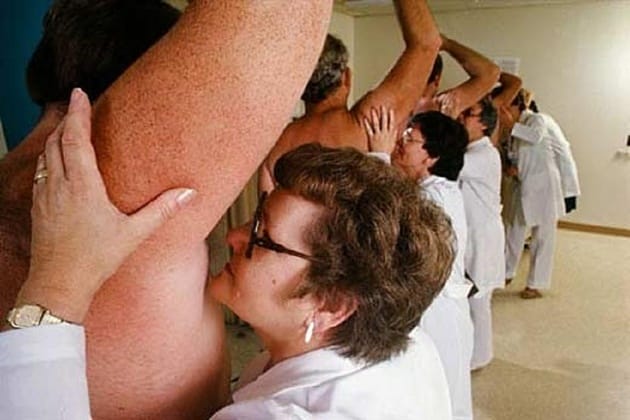In the mid 1990s, the consumer goods company Procter & Gamble thought they had developed a new hit product. Thanks to several million dollars of research, they had created a spray that could eliminate odors. They called it Febreze.
Procter & Gamble (P&G) assembled a marketing team that put together ads showing relieved customers taking deep breaths of fresh air after spraying Febreze on jackets that reeked of cigarette smoke and sofas that stank of wet dog. As related by journalist Charles Duhigg, they got ready for promotions and bonuses as they launched the advertising campaign.
But nothing happened. Sales were low, the P&G executives were alarmed, and the marketing team struggled to figure out what they had done wrong. The epiphany came at the home of a crazy cat lady. Duhigg elaborates:
When P.& G.’s scientists walked into her living room, where her nine cats spent most of their time, the scent was so overpowering that one of them gagged.
According to Stimson, who led the Febreze team, a researcher asked the woman, “What do you do about the cat smell?”
“It’s usually not a problem,” she said.
“Do you smell it now?”
“No,” she said. “Isn’t it wonderful? They hardly smell at all!”
Febreze had failed because people had no idea that they needed the product. In most cases, people simply adjusted to bad smells in their everyday life until they no longer noticed them.
Eighty years earlier, deodorant companies faced a similar problem. The travails of one such company, Odorono (Odor? Oh No!), was chronicled by Smithsonian Magazine. The company began when a Ohio high school student named Edna Murphey attempted to sell an antiperspirant invented by her father, a surgeon. He used it to keep his hands dry during surgeries while Murphey found it prevented sweating and odor on her armpits.
The product was an improvement over what existed. On particularly hot days, women might use “dress shields,” which were simply cotton or rubber pads, to prevent sweat from soaking through their clothing.
But as with Febreze, deodorant solved a problem no one felt they had. People believed regular baths to be sufficient. Men found odor masculine; women found perfume enough to cover up any smells. Worst of all, in the victorian culture of the time, talking about bodily functions or sweaty armpits publicly was taboo.
P&G solved their problem by marketing Febreze as an air freshener. Although aerosols and other fresheners had long existed, good marketing combined with P&G’s market dominance propelled sales. Through the trojan horse of an air freshener, Febreze became a bestseller and anti-odor products became a major product.
The plucky high school student in Cincinnati did not have the flexibility and resources of P&G, but during a long, sticky summer at the 1912 Atlantic city exposition, she made enough sales to hire a copywriter from the J. Walter Thompson Company, an ad agency.
What came next, Sarah Everts explains in Smithsonian, was a marketing coup. After several years of muddling success, the young copywriter, James Young, decided to convince women that they smelled. A first ad – “Within the Curve of a Woman’s arm” – read:
A woman’s arm! Poets have sung of it, great artists have painted its beauty. It should be the daintiest, sweetest thing in the world. And yet, unfortunately, it’s isn’t always.
As Everts writes, his ads suggested to women that they “may be stinky and offensive, and they might not even know it… If [they] wanted to keep a man, [they’d] better not smell.” In other words, Young tried to convince every woman that she was the oblivious cat lady and that the rest of the world was the Febreze marketing team, running off to gag at the smell.
The ad shocked. Young’s female co-workers stopped talking to him and women cancelled subscriptions to magazines running the ad. But it worked. Sales doubled, then rose above a million dollars per year. “Within the Curve of a Woman’s arm” is considered a classic in marketing, an ad that launched the Advertising Hall of Fame career of James Young.
Once deodorant companies pulled the same trick on men – convincing them that their manly odors could get them canned from their desk jobs and putting deodorant in whiskey bottles so it didn’t seem wussy – they had the entire population spending billions to use their products every day.
Odorono and P&G faced a similar problem – their products solved a problem that people either did not have or did not recognize. In response, they took opposite paths to success. The marketers of Febreze changed the connotation of their product from negative to positive. The image of Febreze went from stinky couches to gleaming kitchens, from dealing with bad smells to spraying a nice scent after a morning of cleaning the house. The marketers of deodorant told the world that everyone was gossipping about how bad their armpits smelled.
One campaign went positive and the other negative, and they both worked. But it may be telling which one turned the project of a Cincinnati high school student into a multimillion dollar company.
This post was written by Alex Mayyasi. Follow him on Twitter here or Google Plus. To get occasional notifications when we write blog posts, sign up for our email list.




